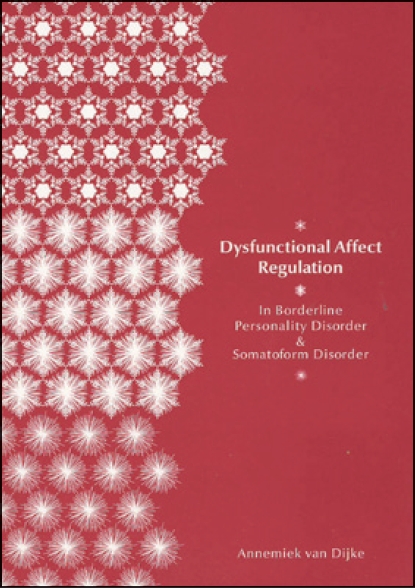Background: Although affect dysregulation is considered a core component of borderline personality disorder (BPD) and somatoform disorders (SoD), remarkably little research has focused on the prevalence and nature of affect dysregulation in these disorders. Also, despite apparent similarities, little is known about how dysfunctional under- and overregulation of affect and positive and negative somatoform and psychoform dissociative experiences inter-relate. Prior studies suggest a clear relationship between early childhood psycho- logical trauma and affect dysregulation, especially when the caretaker is emotionally, sexually, or physically abusing the child, but how these relate to under- and overregulation while differentiating for developmental epochs is not clear. Although an elevated risk of childhood trauma exposure or complex posttraumatic stress disorder (CPTSD) symptoms has been reported in BPD and SoD, trauma histories, dysfunctional affect regulation, dissociation, PTSD, and CPTSD were never assessed in unison in BPD and/or SoD. Method: BPD and/or SoD diagnoses were confirmed or ruled out in 472 psychiatric inpatients using clinical interviews. Dysfunctional under- and overregulation of affect and somatoform and psychoform dissociation, childhood trauma-by-primary-caretaker (TPC), PTSD, and CPTSD were all measured using self reports. Results: No disorder-specific form of dysfunctional affect regulation was found. Although both BPD and SoD can involve affect dysregulation and dissociation, there is a wide range of intensity of dysfunctional regulation phenomena in patients with these diagnoses. Evidence was found for the existence of three qualitatively different forms of experiencing states: inhibitory experiencing states (overregulation of affect and negative psychoform dissociation) most commonly found in SoD, excitatory experiencing states (underregulation of affect and positive psychoform dissociation) most commonly found in BPD, and combination of inhibitory and excitatory experiencing states commonly occurring in comorbid BPD’SoD. Almost two-thirds of participants reported having experienced childhood TPC. Underregulation of affect was associated with emotional TPC and TPC occurring in developmental epoch, 0Á6 years of age. Overregulation of affect was associated with physical TPC. Almost a quarter of all participants met the criteria for CPTSD. BPD’SoD patients had the most extensive childhood trauma histories and were most likely to meet CPTSD criteria, followed by BPD, psychiatric comparison (PC), and SoD. The BPD’SoD and BPD reported significantly higher levels of CPTSD than the SoD or PC groups but did not differ from each other except for greater severity of CPTSD somatic symptoms by the BPD’SoD group. Conclusion: Three qualitatively different forms of dysfunctional regulation were identified: inhibitory, excitatory, and combined inhibitory and excitatory states. Distinguishing inhibitory versus excitatory states of experiencing may help to clarify differences in dissociation and affect dysregulation between and within BPD and SoD patients. Specific interventions addressing overregulation in BPD, or underregulation in SoD, should be added to disorder-specific evidence-based treatments. CPT is particularly prevalent in BPD and BPD’SoD and is differentially associated with under- and overregulation of affect depending on the type of traumatic exposure. CPTSD warrants further investigation as a potential independent syndrome or as a marker identifying a sub-group of affectively, or both affectively and somatically, dysregulated patients diagnosed with BPD who have childhood trauma histories.
Boeken / 17/07/2011
In Borderline Personality Disorder & Somatoform Disorder
Dysfunctional affect regulation
Opmerkingen
0
Log in om te reageren op dit artikel.



